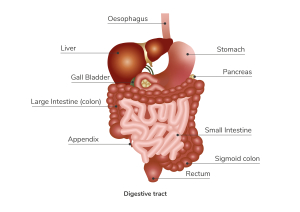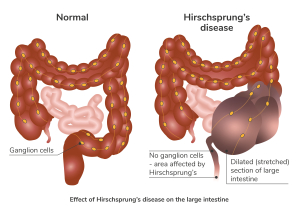Hirschsprung’s Disease
About 150 children in the UK are born with Hirschsprung's disease each year. It is a condition where nerve cells (also called ganglion cells) within a section at the end of the child's bowel don't develop properly. The section of bowel which does not contain ganglion cells isn't able to relax, and acts like a blockage, preventing the child from pooing properly. As well as preventing a child from pooing properly, the blockage in the child's bowels will often cause them to have a very swollen tummy and to vomit bile (green coloured vomit), and can also cause them to develop a very severe infection called Hirschsprung's Associated Enterocolitis. Most children with Hirschsprung's disease will need an operation to remove the section of the bowel which doesn't contain ganglion cells.


Description of Diagrams
Food is carried from the mouth to the stomach via a tube called the oesophagus. After the stomach, food enters the small intestine. The small intestine is a long, thin tube which runs in the central part of the abdomen, and then connects to the large intestine in the bottom right of the abdomen. The large intestine is much wider than the small intestine, and runs up the right hand side of the abdomen, across the top of the abdomen, down the left hand side of the abdomen, and eventually into the pelvis, where it connects with the anus (where poo leaves the body). The last two parts of the large intestine are called the sigmoid colon and the rectum.
Throughout the intestine, there are networks of special nerve cells called ganglion cells. In Hirschsprung's disease, these ganglion cells are missing from the end of the large intestine nearest to the anus. The large intestine that is missing ganglion cells becomes contracted and narrow, whilst the intestine that is upstream of the section where the ganglion cells are missing becomes dilated (stretched).
More information about Hirschsprung's disease can be found on the NHS website.
The following sources of information and support are also available:

